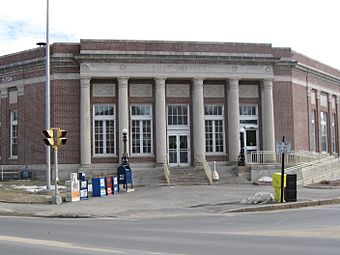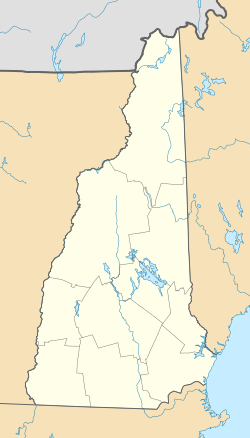U.S. Post Office-Laconia Main facts for kids
Quick facts for kids |
|
|
U.S. Post Office-Laconia Main
|
|
 |
|
| Location | 33 Church St., Laconia, New Hampshire |
|---|---|
| Area | 0.7 acres (0.28 ha) |
| Built | 1917 |
| Architect | Office of the Supervising Architect under James A. Wetmore |
| Architectural style | Beaux Arts |
| NRHP reference No. | 86002252 |
| Added to NRHP | July 18, 1986 |
The U.S. Post Office-Laconia Main is a very old and important building. It is located at 33 Church Street in Laconia, New Hampshire. This building was finished in 1917. It is a great example of a building style called Beaux Arts. Because it is so special, it was added to the National Register of Historic Places in 1986. This list helps protect important buildings.
About the Laconia Post Office
The main post office in Laconia is in the northeast part of downtown. It sits on the corner of Church and Beacon streets. It's a single-story building made of brick with stone decorations.
What Does It Look Like?
The main door is on the corner of the building. It has six tall, fancy columns in front. These columns are called Corinthian columns. Stairs lead up to the entrance. On each side of the stairs are cool old lamp posts made of iron. They have round lights.
The entrance doors are now modern. Next to the doors are windows that open outwards, with smaller windows above them. There are also carved designs above these windows. The top of the building has a decorative edge called a parapet. This edge goes all around the building.
The sides of the building each have three windows. Brick pillars separate these windows. Above each window are decorative stone panels.
Inside the Building
The main lobby inside has been updated over time. But it still has beautiful paintings on the walls. These paintings show the natural beauty of the area. An artist named Loran Percy painted them in 1980 and 1982.
Who Designed It?
The Laconia Post Office was built between 1916 and 1917. The design came from a special group called the Office of the Supervising Architect. This group was part of the United States Department of the Treasury. At that time, James A. Wetmore was in charge of the office.



